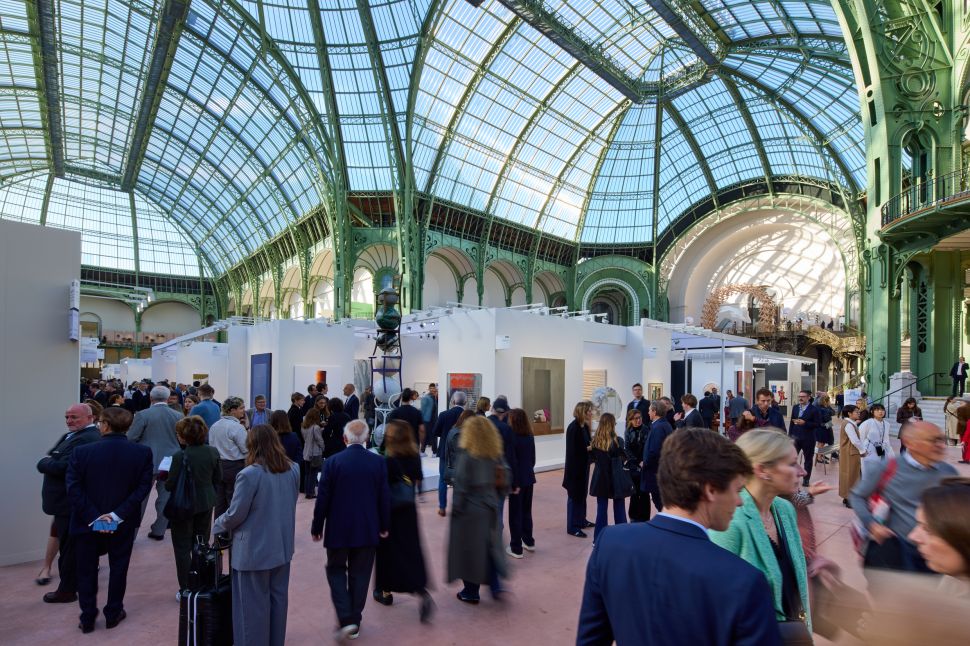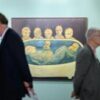
Presented yesterday (Oct. 24) at Spring Studios in New York, the latest Art Basel and UBS Survey of Global Collecting offered key insights into collectors’ activities and attitudes at a time when the art market is undergoing major shifts in transaction channels, demographics and buying habits. The discussion, moderated by the Wall Street Journal’s Kelly Crow, featured Clare Mcandrew, the report’s author and founder of Arts Economics; Noah Horowitz, CEO of Art Basel; and Paul Donovan, chief economist at UBS Global Wealth Management. Together, they unpacked new analyses of the behavior of high-net-worth individuals (HNWIs) across fourteen global markets in 2023 and the first half of 2024. The UBS survey, the largest of its kind to date, drew on responses from 3,660 highly engaged and wealthy art collectors—individuals with a net worth of over $1 million, excluding real estate and business assets.
The findings revealed robust and steady activity in the market but highlighted a notable decline in average spending, along with a narrowing of the high-end sector. However, this trend hinted at ongoing sustainability in other segments. Despite the 2023 slowdown, which saw the art market fall by 4 percent to $65 billion, global imports of art and antiques grew for the third consecutive year, with values rising by 6 percent to $33 billion. As McAndrew noted, “The HNWIs we surveyed were transacting through a more diverse range of channels and price points in 2023 and 2024, engaging with more galleries than in previous years, including more new galleries. These changes will likely contribute to the ongoing shift in focus away from the narrow high-end sales that have dominated in previous years, potentially expanding the market’s base and encouraging growth in more affordable art segments, which could provide greater stability in the future.”
How HNWIs are spending on art
While the world’s billionaires experienced a 5-7 percent decrease in growth compared to the striking 64 percent surge from March 2020 to March 2021, the distribution of their wealth shifted, influencing buying and investment choices. According to the survey, HNWIs saw a 32 percent drop in average spending, largely due to reduced activity at the top of the market. Spending dipped slightly from $50,165 in 2022 to $50,000 in 2023, which helped stabilize the middle market, with median spending levels reaching $25,555 in early 2024.
Horowitz said that, “despite this, median spending in 2023 and through the first half of 2024 remained solid, with a growing focus on new and emerging artists, and art-related event attendance surpassing pre-pandemic levels. As a global business, we recognize the challenging market context and remain committed to fostering new and innovative ways for the next generation of collectors to connect with our galleries and their artists—both at our shows and beyond.”
Painting continued to dominate as a preferred medium, with three-quarters of HNWIs purchasing a painting in both 2023 and early 2024. Works on paper also gained traction, with half of respondents actively investing in this category, while prints saw a notable 35 percent increase. Meanwhile, sculptures and more complex media saw reduced spending, largely due to market activity concentrating at lower price points.
SEE ALSO: Observer’s Guide to This Year’s Must-Visit November Art Fairs
As the top end of the market contracts, HNWIs are increasingly drawn to emerging artists. Total expenditures in this category grew by 8 percent in 2023 and 2024, with 52 percent of spending directed towards early-career artists. Interest in living artists also rose, with 17 percent of HNWIs investing in their works, compared to a 9 percent decline in other categories. Mid-career artists accounted for 21 percent of expenditures, while established and top-tier works made up 26 percent.
Reflecting broader institutional trends, gender parity in private collections improved. The share of works by female artists in HNWI collections rose to 44 percent in 2024, the highest level in seven years, up from 33 percent in 2018.
When it comes to motivations for collecting, personal enjoyment remained the top driver, cited by 40 percent of respondents. However, financial motivations ranked higher in Singapore, and in Brazil, they were almost on par with personal reasons. Social motivations, such as building connections with like-minded individuals, accounted for 24 percent of responses.

HNWI buying channels
During the discussion, McAndrew emphasized that collectors are attending more art events than ever before. Across all fourteen markets, HNWIs attended an average of forty-nine art-related events in 2023, with plans to attend nearly as many in 2024. But when it comes to actual transactions, many collectors are increasingly comfortable buying online, with 29 percent making purchases digitally and 23 percent buying through Instagram. The second most commonly used and second-largest spending route was dealer websites, which emerged as the preferred method among HNWIs in 2024. However, 20 percent of collectors still prefer to buy in person at events or gallery exhibitions.
As the art market continues to adopt a multichannel approach, accelerated by the pandemic, 60 percent of HNWI spending in 2024 was channeled through dealers. This spending was split between gallery visits (28 percent), online transactions (25 percent), art fairs (18 percent), email or phone sales (18 percent) and Instagram sales (11 percent). The most popular avenue for purchasing art remains galleries or art dealers, with 95 percent of HNWIs using this method, while auctions held a secondary position, with 67 percent making purchases at auction in 2024.
The survey also suggested that HNWIs are broadening their horizons to explore new galleries and channels for their acquisitions. Eighty-eight percent of respondents purchased from at least one new dealer in the last year, buying from an average of seventeen different galleries in 2024. Despite increased travel to fairs and biennales, collectors still exhibit a “home” bias, purchasing primarily from local galleries. Additionally, the survey shows that while HNWIs attended both local and international events, 54 percent leaned toward local events.




Wealthy collectors are increasingly focused on legacy and estate planning
One intriguing aspect of the survey is how the ongoing generational transfer of wealth among HNWIs, particularly in North America and Europe where we are witnessing one of the largest transfers in history, is impacting art collections. According to Donovan, “over the next 20 years or so, $84 trillion will change hands. That is roughly 1.7 times the treasury bond market. So there’s a lot of money moving around.” He also noted in a statement that “as the great wealth transfer gains momentum, we will see partners, spouses and children take on collections and become collectors themselves. These new collectors will bring fresh perspectives, often adopting new strategies that are more purpose-led.”
The survey projects that the wealthiest segment of HNWIs is likely to transfer over $6 trillion in wealth and assets to heirs and charities over the next 20 to 30 years. This shift inevitably involves careful planning for pleasure assets, including art collections, many of which have already been passed down through generations. According to the findings, 91 percent of these collectors inherited or were gifted works through wills or other bequests, and 72 percent have kept at least some of those pieces. Additionally, 65 percent of respondents have plans in place to transfer artwork to a partner or spouse, while 43 percent have a similar plan for children. But as the panel highlighted, practical reasons often drive sales—chief among them are the high inheritance taxes that collectors seek to avoid or use proceeds to settle (47 percent), as well as the need for physical space to house artworks (55 percent).




Donovan highlighted that this wealth transfer is also enabling more women to take control of significant financial assets: “We do see women taking more control of wealth, and there’s sometimes a stereotype that women are risk averse. This is absolutely not the case. However, they are willing to do their research when making investment decisions and broader decisions about wealth management. In general, we are seeing people being more considerate in some of their art purchases.”
This shift also applies to Gen Xers and Millennials, who are set to inherit this wealth. According to the report, their attitudes toward spending are changing. While younger buyers saw notable increases in average spending in 2022, 2023 marked a 50 percent drop in millennial HNWI spending, down to an average of $395,000. However, median spending across all generations remained consistent, ranging from just under $47,000 for Millennials to $52,000 for Boomers in 2023. Gen X had the highest average spending of $578,000 (over a third higher than Millennials and double that of Boomers and Gen Z), showing a modest year-on-year growth of 3 percent. A looming question remains: once this wealth is transferred, will they keep the inherited art or sell it?
“This year’s Art Basel and UBS Survey of Global Collecting shows that the drop in average spending among millennial HNWIs was driven by reduced activity from high-end buyers, reflecting a broader market shift,” Horowitz said in a statement. “Despite this, median spending in 2023 and through the first half of 2024 remained solid, with a growing focus on new and emerging artists, and art-related event attendance surpassing pre-pandemic levels. As a global business, we recognize the challenging market context and remain committed to fostering new and innovative ways for the next generation of collectors to connect with our galleries and their artists—both at our shows and beyond.”
Overall, the 2024 collector survey offers a ray of hope: the percentage of HNWIs feeling optimistic about the global art market’s performance in the next six months had risen to 77 percent by the end of 2023, with 43 percent planning to buy in the next twelve months. The most proactive buyers are those with financial motivations; 70 percent are actively planning purchases. The report additionally spoke of “positive economic forecasts for 2025” and “continued art enthusiasm driven by both seasoned collectors and new entrants,” supported by early indicators such as sustained spending in mainland China, growing interest in emerging artists and consistent attendance at galleries and art fairs. Though the market continues to course correct after the pandemic-driven euphoria, the survey points to a solid and resilient base that could sustain the market in the year ahead.
This post was originally published on this site be sure to check out more of their content







